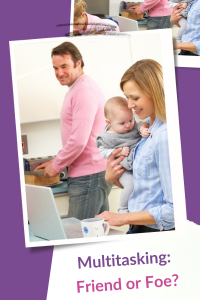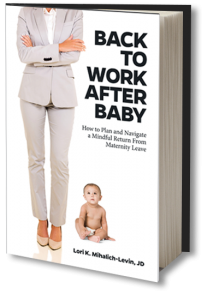 Ah, multitasking. It’s a word that’s used often to describe the “superhero” nature of working parents. But is it really all it’s cracked up to be? In my opinion: yes and no.
Ah, multitasking. It’s a word that’s used often to describe the “superhero” nature of working parents. But is it really all it’s cracked up to be? In my opinion: yes and no.
One of the (many) soapboxes I often find myself getting on is the reminder that working parents make amazing leaders. Yes, we often have the fog of “baby brain” when our kids are little, but we also get the amazing baby brain that comes with new neural networks and a literal brain explosion. As my friend and colleague Amy Henderson says, parenthood has the ability to unlock “career critical skills” that are exactly the types of things organizations spend tons of money training employees on.
When I give talks on the transition back to work after parental leave, I always ask my audience to brainstorm skills they believe they are growing through parenthood. And inevitably, in every audience, one or more parents says “multitasking.”
I take the nature of their comment to be that we learn to juggle a million things at once. Washing dishes while feeding nuggets to a toddler while talking to a client on the phone. Scheduling a pediatrician appointment while tuning into a webinar, while answering an e-mail to a boss. We simply have more to do, and so we find ways to get it all done.
What we think we are multitasking, though, often ends up being an endless day of “task switching.” Rapidly flipping from one to-do to the next, one open item to another. And this task switching actually slows us down.
Today, I’m here to talk about why I’ve gotten a bit cringy when anyone touts “multitasking” as a working parent superpower. What follows is my current soapbox, and a reframe I really like.
Is It Multitasking or Task Switching?
A few years ago, I had the good fortune of participating in a year-long program for women law firm attorneys called the Women’s Leadership Forum. In one of our lessons, we explored the multitasking question with an exercise that really stuck with me.
First, we were asked to write the sentence, “I am a great multi-tasker.” And our coach timed us. Then, she asked us to write the same sentence, but after each letter in the sentence, we needed to stop and write the numbers 1 through 20 below each letter. (So, for example, you’d write “I” then “1”, “a” then “2” and so forth.) She timed us for that exercise, too. In theory, you’d think it would take us about twice the amount of time to do the second exercise as the first, right?
WRONG. Collectively, were *many times* slower at writing each line when our brains had to switch back and forth between the letters and the numbers. With zero exceptions. No one in the group of talented attorneys outsmarted this one. (Don’t believe me? You *can* try this at home!)
So you think you’re efficient and multitasking by doing two activities at once. But in reality, you’re slowing down the whole process of doing each task. As the Cleveland Clinic reports, “Studies show that when our brain is constantly switching gears to bounce back and forth between tasks – especially when those tasks are complex and require our active attention – we become less efficient and more likely to make a mistake.”
This point is reiterated in this great 3 minute interview on YouTube with efficiency guru, Christine Carter, PhD. Dr. Carter says we lose up to 25% of our time when we task-switch, and we are far more error-prone. All the switching makes us tired and distracted, too.

A Reframe I Really Like
As working parents with a million things on our plates, how are we supposed to get it all done, then? It can’t possibly be that we toss all multi-tasking out the window, can it?
In an ideal world with unlimited time and resources, perhaps we could each mindfully complete each task we are assigned. We could be fully present while we take each bite of our meals. And sit quietly while we talk to a friend. But I certainly don’t live in that ideal world. And I suspect you don’t either.
The multitasking advice that has resonated most with me of late has been Marisa Lonic’s advice to “multi-task the mindless” and “single-task the mindful.” (Check out her book, Time Momagement for more.) In other words, if you’re doing an activity that you can do on auto-pilot (e.g. folding laundry), then by all means, multitask that activity. As Dr. Carter says, it’s perfectly fine to “combine an autopilot task with an intellectual one.” But if you’re engaged in an activity that requires cognition and the use of your actual, thinking brain, then single-task that activity.
Set an Intention for Today
The habit of task-switching (and erroneously calling it multi-tasking!) is deeply engrained in so many of us. We learn it through our families and culture, and sometimes we wear it around our neck like a medal. So how can we change this deeply-rooted habit? As with anything, one day at a time.
Yesterday, I set an intention for my day that was one simple word: “single task.” (More on daily intention-setting here: How to Set a Daily Intention: Instructions for a Working Parent.) My intention for the day was to single-task most things, and avoid unnecessary task-switching. Did I do this perfectly all day long? Nope. But did I make some progress in it and feel more productive than usual? Yep.
For starters, perhaps pick one project or intellectual activity that you commit to single-tasking. Set a timer for 25 minutes and “do a Pomodoro” by focusing only on that one single task, just as an experiment. Ask yourself afterward how your brain felt, and how your body felt. One hour at a time, one day at a time, I’m convinced we can re-wire ourselves for a calmer existence.
Want more practical tips on working parenthood? Check out my book, Back to Work After Baby: How to Plan and Navigate a Mindful Return from Maternity Leave


